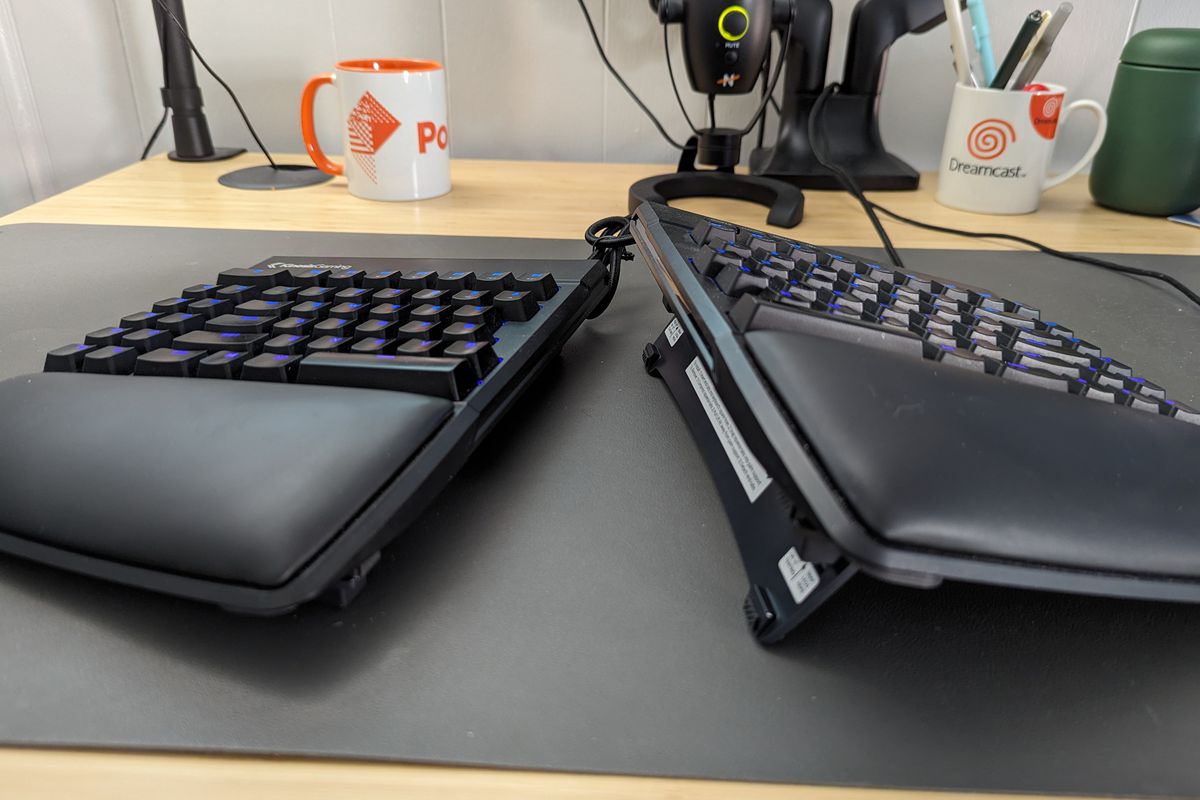In the early days of the COVID-19 pandemic, I faced a dilemma that might be familiar to many computer users: My wrists were killing me. I was pulling eight-hour shifts at work, then playing more games on PC than ever on the same setup to stay connected to friends during a bleak time. I hadn’t experienced wrist pain from typing before, but it was so bad that I couldn’t go on without finding a more comfortable alternative that had at least some of the bells and whistles I expected from a modern gaming keyboard.
I eventually found a solution that met my criteria for a gaming keyboard as well as an ergonomic one, a combination of needs that I supposed would never intersect — at a reasonable price, at least. I found the Kinesis Freestyle Edge RGB, and while $199.99 might not be “reasonable” to some, it’s more affordable than other split keyboards that have similar features.
The main feature that distinguishes the Kinesis from most other keyboards is that it’s split into two parts, with each chunk connected by a cable. In case you were wondering, yes, there is a learning curve to typing on this kind of keyboard. How tough it’ll be will depend on what your typing is like on a traditional keyboard. If you use the keyboard’s home rows, like you might’ve learned in computer class as a kid, it probably won’t take you long to acclimate, but if you hunt and peck for keys, the split layout may be more of a challenge.
Since the Freestyle Edge RGB is split, you can position each half exactly how you want as long as the two sides don’t stretch beyond the cable’s 20-inch length. So, instead of bending my wrists outward to type on conventional layouts, my arms and wrists can be more relaxed, typing at a position and angle that feels more natural. On my desk, the keyboard halves barely touch each other. It’s bliss. If you play games like Microsoft Flight Simulator, you can even move either half out of the way to make room on your desk for a HOTAS controller.

Image: Kinesis
Despite its looks, the Freestyle Edge RGB is similar to other gaming keyboards. It has mechanical keys with the option to select Cherry MX Blue (clicky), Red (linear), Silver (fast linear), or Brown (tactile) switches in case you have a preference, and each key is backlit with RGB LEDs that can be customized in Kinesis’ SmartSet app. This model also includes detachable palm rests that lift your wrists up for an even cozier typing experience.
That’s all great, but this keyboard is a star because it has N-key rollover (NKRO), a feature that allows the user to press any number of keys at once. I found out the hard way that my previous split keyboard didn’t support it during the heyday of Halo Infinite’s very fun online multiplayer; I couldn’t simultaneously hold down shift to sprint, hit space to jump, hold W to move forward, and toss a grenade with the G key. NKRO is a basic gaming feature in many affordable gaming keyboards, but you’ve got to search a little harder for it in ergonomic models. Thankfully, it’s available with the Freestyle Edge RGB, which is just as responsive and capable as the next gaming keyboard, ready for any series of key presses.

This Kinesis keyboard supports an add-on ergonomic feature that leaves other gaming keyboards in the dust. The $29.99 Lift Kit comes in two pieces, each snapping onto the underside of the Freestyle Edge RGB to provide some lift, so your wrists can be opened (oriented more like you’re going in for a handshake instead of laying flat). These let the keyboard halves be tented independently of each other at multiple angles. The lowest 5- and 10-degree angle options tilt each side upward slightly, while the 15-degree angle provides a steeper pitch that may look strange, but in my experience, quickly felt normal to type on.
One small complaint I have with the Freestyle Edge RGB is that, compared to pricier options like the ErgoDox EZ and the Matias Ergo Pro, it doesn’t support sloping, which would elevate your palms so that they’re higher than your fingers. It would have been ideal if the add-on V3 Pro Lifters kit enabled this. Still, for the money, the Freestyle Edge RGB offers just enough for full- or part-time gamers and desk workers who want to catch a break from wrist pain.
- SEO Powered Content & PR Distribution. Get Amplified Today.
- PlatoData.Network Vertical Generative Ai. Empower Yourself. Access Here.
- PlatoAiStream. Web3 Intelligence. Knowledge Amplified. Access Here.
- PlatoESG. Carbon, CleanTech, Energy, Environment, Solar, Waste Management. Access Here.
- PlatoHealth. Biotech and Clinical Trials Intelligence. Access Here.
- Source: https://www.polygon.com/gaming/24099950/kinesis-freestyle-edge-rgb-split-ergonomic-gaming-keyboard-comfort-recommendation



